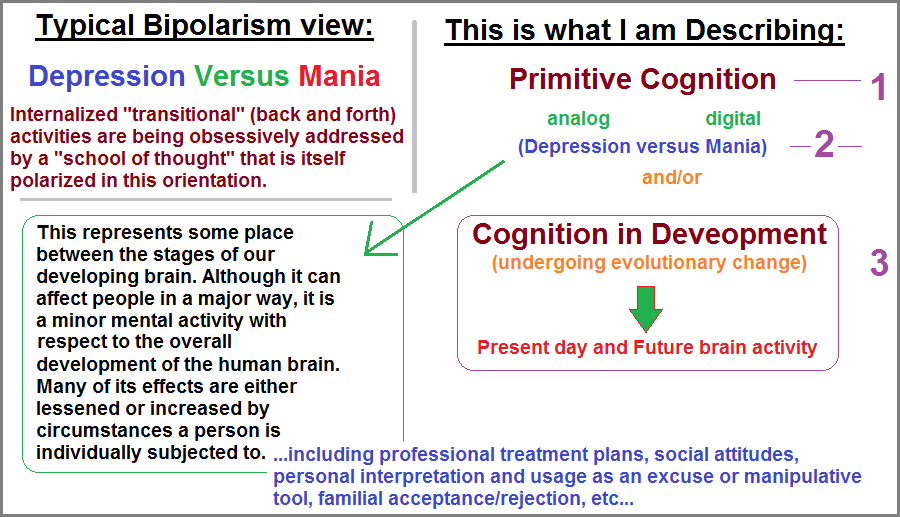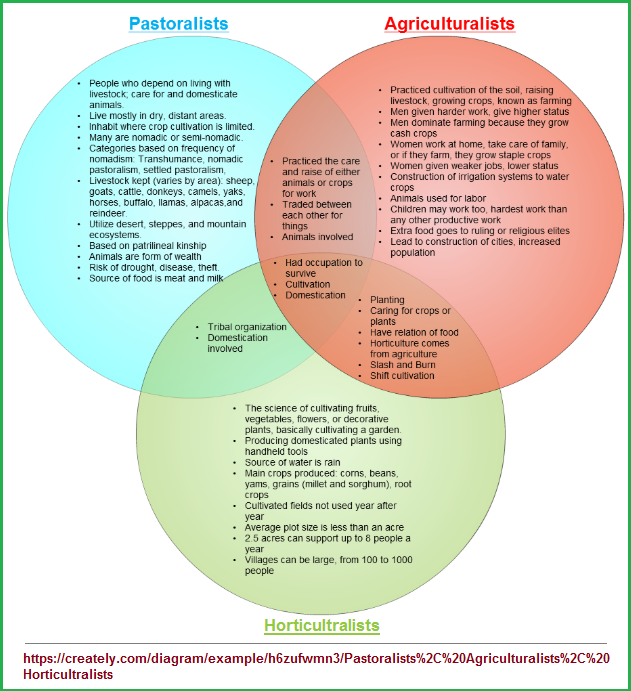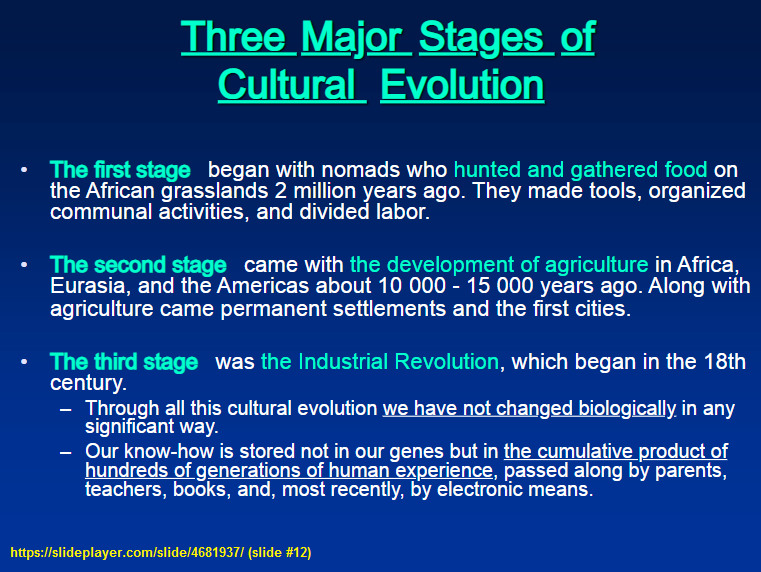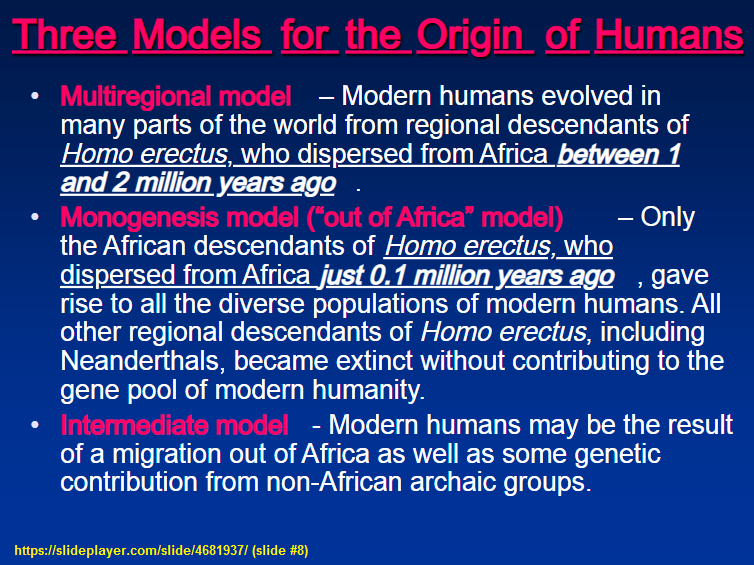~ 36 ~
~ The Study of Threes ~
http://threesology.org
| Devil's Advocate Series: | ||||||||
|---|---|---|---|---|---|---|---|---|
| pg.1 | pg.2 | pg.3 | pg.4 | pg.5 | pg.6 | pg.7 | pg.8 | pg.9 |
| pg.10 | pg.11 | pg.12 | pg.13 | 14A 14B |
pg.15 | pg.16 | pg.17 | pg.18 |
| pg.19 | pg.20 | pg.21 | pg.22 | pg.23 | pg.24 | pg.25 | pg.26 | pg.27 |
| pg.28 | pg.29 | pg.30 A | pg.30 B | pg.31 | pg.32 | pg.33a | pg.33b | pg.33c |
| pg.34 | pg.35 | pg.36 | pg.37 | pg.38 | pg.39 | pg.40 | pg.41 A | pg.41 B |
On the previous page I spoke of transitioning, of overlap, and I suggested that the notion of "Bipolarism" may be representative of a transitional overlap that is sometimes unjustly interpreted and defined in a negative way such as when describing alternatively occurring behavior or thought or emotion in a person in a negative way, perhaps as a means of trying to manipulate them to bring about some personal reward. Let us look at a typical perspective of Bipolarism versus that which I am trying to propose:

Yet, this view of looking at Bipolarism as an overall cognitive transition (and I am not speaking of it in terms of being a part of the mania/depression sequence), implies that all dichotomies may possibly be representative of unrecognized transitions to what, when and where... and why, I do not know. Nor do I know if it is appropriate to describe the to-be transitional state or stage as that being some definitive expression or that which can be accurately described as a "three", when "third" in an ongoing series, may be more of exacting as a generalization itself. Then again, taking this view necessarily suggests that those patterns-of-three being assumed to be some definitive expression may themselves be little more than a way-station (some point in-between) on a longer route... a means by which a breather to catch one's breath— so-to-speak, can take place, if we need some means of describing a transition within a transition (within one or more other transitions?)... as one might describe the sets-of-three used in our numbering sequence (ones-tens-hundreds, thousands... etc...). The sets-of-three used in counting sequences as partialized groups are themselves transitions before and between other groups, including the initial 1,2,3... or first three numbers which are likely preceded by some other cognitive arrangement, though numbers or a means of articulation may not necessarily be in common usage or even acknowledgment.
Patterns-of-three can also be representations of transition, though they are used to imply a perceived state of completeness, such as one might claim that the three germ layers (endoderm- mesoderm- ectoderm) or the three basic larger particles of atoms (protons- neutrons- electrons) are definitive expressions of complete designs... in that there is no forth Germ layer and no forth particle... otherwise it is either the "three" orientation is wrong, or that the existence of a forth means we need a new means of identifying and labeling fundamental structures... since the presence of a forth may suggest the presence of a fifth... etc., thus describing an inexactness to our perceptions and/or labeling thereof. In other words, if the numbering system is wrong, is it us, or numbers themselves?
As an acquaintance of mine (Richard Williams) is fond of saying: Figures don't lie, but liars can figure. Hence, has humanity configured a numbering system that has an inherent inclination to lie, and we humans set the stage, scenery and script defining the extent to which the lies are to be used and believed in?
Let us take for example, the present Christian Trinitarian concept of Father-Son-Holy spirit and the Hinduist tripartite god complex of Brahma-Vishnu-Siva seen as supposed definitive representations using the value of "three". These and others may be little more than some emblematic symbol of underlying development occurring with the human brain that is itself an expression of some underlying developmental occurrence, and it too... so on and so forth; whereby using a process of reductionist deduction arrive at the atomic level which may also be representative of yet some other more basic change in transition... but we humans with our present ego are inclined to assign some especiality to a given idea to suggest greatness and completeness that we claim ownership of.
When we see a pattern-of-three, for example, of human activity such as pastoralists- agriculturalists- horticulturalists, the idea of overlap and transition may or may not come to mind... including the absence of consideration that these ideas represent types of behavior that developed over time and not necessarily in sequence or either in absence of one another in all circumstances. Just because some historian or ethnobiologist describes what they believe to be a given scenario of development does not mean we have to automatically take their so-called "professional" word for it. Additionally, just because a person has studied a subject their entire life doesn't mean they can't be wrong either in interpretation or even perception of that to be labeled or defined... though they may be quite adept at coining a word or concept or model or experimental procedure, etc., for the given subject which they may have also pioneered. While the listing of "Pastoralists- Agriculturalists- Horticulturalists is a pattern-of-three, the word "Horticulture" is viewed as an underlying segment of Agriculture, thus leaving us with an embellished pattern-of-two masquerading as a pattern-of-three. I suspect we can find other instances of this as well, thus providing us with multiple examples of what I think reflect the human brain exercising an effort to grow beyond its usage of dichotomies but has not yet acquired a full expression thereof. Yet, if a full expression does in fact exist, what type of brain is it that uses it? As a mental doodle to fidget with when confronted by a world dominated by patterns-of-two? ... like a left handed person being confronted by a world crafted by a dominance of right-handed people?

While there have been those striving to make some connections between and among Indo-European peoples, Africa peoples, Asian peoples, etc., using different criteria such as song, music, dance, socio-cultural terms, mythology, religion, language, etc., little talked about on an everyday level is the usage of the pastoral, agricultural, and horticultural ensemble-of-three, though the latter may be more familiar if cast with the image of herbalism, such as used for medicine in an overall pharmocopedia orientation or as a study in anthropological medicine, occurring with both pastoralists and agriculturalists, with or without naming horticulture in the mix. Though such research is not unknown and is explored from different vantage points, I am going to attempt a short interpretive, albeit, superficial refrain in terms of overlap and transition from a point of generality, because I have no real in depth knowledge of either of these in any culture, including my own. Then again, nor do most people. Yet, we can think of these three in general terms after a short definition (with referential information) is given for them, if the accompanying information on the above image is not too difficult to read and can be used as a generalized supplementation for the forthcoming definitions. However, let us begin with a reference about human societies. (Notice the usage of dichotomies: past/present, primitive/civilized, simple/complex, tiny/huge, scattered/dense, prestate/state, civilized/(non-civilized), urban/(rural):
So great are the variations in ways of life, past and present, that comparisons among them are difficult. Any simple classification of human societies and cultures can only be viewed as arbitrary. From a modern urban point of view, nevertheless, there is the obvious distinction between the primitive and the civilized: between simple and complex societies; between tiny and huge social agglomerations; between scattered and dense populations; and, above all, between prestate societies and societies that have developed states. In general, civilization involves the rise of legal institutions and the acquisition of a legal monopoly of force by a government. Those developments made possible the cities and empires of classical times and the growth of dense populations. Thus "civilized" is nearly synonymous with "urban."
The varieties of non-urban, or primitive, societies may be further classified. One way is by the methods they use to get food. Those who hunt and gather behave quite differently, as societies, from herdsmen and mounted predator-warriors, the pastoralists, who in turn live quite differently from the various kinds of agriculturalists. These distinctions are not sharp, for of course there are societies that combine foraging with some agriculture, others, some agriculture and some herding; and, in a few cases, a class of herders may live in the same society with a class or caste of agriculturalists. A continuum of societies may be constructed, ranging from tiny, simple bands of hunter-gatherers in poor environments to large, dense populations of irrigation agriculturalists—that is, from the entirely nomadic to the fully sedentary. The degree to which societies approach the sedentary deserves prominence in any classification since sedentary ways are accompanied by many other cultural traits and institutions.
Elman R. Service, Professor of Anthropology, University of California: "primitive culture." Encyclopædia Britannica Ultimate Reference Suite, 2013.
- Nomadism accompanied with scavenging behavior is generally thought to have preceded the "industry" of Pastoralism and Agriculturalism, and is in effect, a behavior used by many individuals in present day contexts of day-to-day living; though in many cases a person may have a job or presumed career that they use as a "base camp's" primary means of foraging for food, clothing, shelter, etc... (Some people spend more time working or away from their residence that such a place(s)) of habitation can be viewed as their primary "home base"... though some people live out of their vehicle from which they conduct a business or work out of to accomplish tasks which may involve traveling to different places. (For example, construction workers, handyman tasks, plumbers, electricians, appliance repairers, etc...)
- Pastoralism is chiefly looked upon in terms of a domesticated (farm) animals husbandry being practiced today, though its usage in the past was chiefly one of "human husbandry" in relation to the movement and "herding" of people for good or ill, such as in the case of a mobile tribe or clan, that may be interpreted to occur in the present day sense of itinerant gypsies or "travelers" as they might be called in Britain. A note of interest is the idea that Ghenis Kahn used the herding of animals such as sheep, to learned to develop his military-like strategies for decimating the livelihoods of a supposed number of millions of people, in that they typically stayed in one place and were docile, to the point where easy capture and slaughter could be effected.
- Agriculturalism refers to those whose primary lifestyle is one in which plant cultivation (with or without trees), is the central occupation.
- Horticulturalism is a term often used to describe a specialized branch of Agriculturism:
Horticulturalism is the branch of plant agriculture dealing with garden crops, generally fruits, vegetables, and ornamental plants. The word is derived from the Latin hortus, "garden," and colere, "to cultivate." As a general term, it covers all forms of garden management, but in ordinary use it refers to intensive commercial production. In terms of scale, horticulture falls between domestic gardening and field agriculture, though all forms of cultivation naturally have close links.
Horticulture is divided into the cultivation of plants for food (pomology and olericulture) and plants for ornament (floriculture and landscape horticulture). Pomology deals with fruit and nut crops. Olericulture deals with herbaceous plants for the kitchen, including, for example, carrots (edible root), asparagus (edible stem), lettuce (edible leaf), cauliflower (edible flower), tomatoes (edible fruit), and peas (edible seed). Floriculture deals with the production of flowers and ornamental plants; generally, cut flowers, pot plants, and greenery. Landscape horticulture is a broad category that includes plants for the landscape, including lawn turf, but particularly nursery crops such as shrubs, trees, and climbers.
Source: "horticulture." Encyclopædia Britannica Ultimate Reference Suite, 2013.When speaking of transition and overlap occurring with human behavior, cultural anthropologists of the 18th and 19th centuries used the terminology "Unilinear cultural evolution" that later researchers put aside in favor of "Multilineral cultural evolution", though it is not known if the "one to many" pattern of human cognition was recognized, nor recognized widely today. Let's take a short step into this area of discussion:
Cultural evolution is also called socio-cultural evolution and refers to the development of one or more cultures from simpler to more complex forms. The subject may be viewed as a Unilinear phenomenon that describes the evolution of human behaviour as a whole, or it may be viewed as a multi-linear phenomenon, in which case it describes the evolution of individual cultures or societies (or of given parts of a culture or society.
Unilinear Cultural Evolution
Unilinear cultural evolution was an important concept in the emerging field of anthropology during the 18th and 19th centuries but fell out of favour in the early 20th century. Scholars began to propagate theories of multil-inear cultural evolution in the 1930s, and these neo-evolutionist perspectives continue, in various forms, to frame much of the research undertaken in physical anthropology and archaeology, the branches of anthropology that focus on change over time.
The Age of Discovery introduced 15th- and 16th-century Europeans to a wide variety of "primitive" cultures. Almost immediately, European intellectuals began efforts to explain how and why the human condition had come to be so diverse. Although the 17th-century English philosopher Thomas Hobbes was very much mistaken when he described indigenous peoples as living in conditions in which there were "no arts, no letters, no society" and experiencing life as "solitary, poor, nasty, brutish, and short," his description encapsulates the era's popular conception of the "savage." Ignoring or unaware of a variety of facts—many indigenous peoples enjoyed a much better standard of living than European peasants, for instance—Hobbes and other scholars posited that everything that was good and civilized resulted from the slow development away from this "lowly" state and toward the "higher" state represented by the cultures of Europe. Even rationalistic philosophers such as Voltaire implicitly assumed that the "upward" progress of humankind was part of the natural order.
This Enlightenment notion that there was, in fact, a "natural order" derived from the philosophers of ancient Greece, who had described the world as comprising a Great Chain of Being—a view in which the world is seen as complete, orderly, and susceptible to systematic analysis. As a result, scholarship during the Enlightenment emphasized categorization and soon produced various typologies that described a series of fixed stages of cultural evolution.
Most focused on three major stages, but some posited many more categories. For instance, in his Esquisse d'un tableau historique des progrès de l'esprit humain (1795; Sketch for a Historical Picture of the Progress of the Human Mind), the Marquis de Condorcet listed 10 stages, or "epochs," of cultural evolution. He posited that the final epoch had begun with the French Revolution and was destined to usher in universal human rights and the perfection of the human race. The Danish archaeologist Christian Jürgenson Thomsen is widely acknowledged as the first scholar to have based such a typology on firm data rather than speculation. In Ledetraad til nordisk Oldkyndighed (1836; A Guide to Northern Antiquities), he categorized ancient European societies on the basis of their tools, calling the developmental stages the Stone, Bronze, and Iron ages.
Multi-lineal Cultural Evolution
A widespread reaction against sweeping generalizations about culture began in the late 19th century in the United States and somewhat later in Europe. Theories and descriptions of hypothetical stages of evolution generally, and of Unilinear evolution specifically, were heavily criticized as racist; instead of presuming that some peoples were more evolved than others, the new trend was to regard all cultures as unique in time and place. In the United States this movement, known as cultural particularism, was led by the German-born anthropologist Franz Boas.
Boas and several generations of his students—including A.L. Kroeber, Ruth Benedict, and Margaret Mead, turned completely away from broad generalizations about culture and concentrated on fieldwork among traditional peoples, harvesting a great variety of facts and artifacts as empirical evidence of cultural processes within existing societies. The creation of encyclopaedic lists of cultural traits and changes therein led to the development of "culture histories" and dominated American anthropology for the first half of the 20th century. The culture history movement so influenced anthropology that grand theories of “Man” became far less common than in the past.
By mid-century, however, a number of American anthropologists, including Leslie A. White, Julian H. Steward, Marshall D. Sahlins, and Elman R. Service, had revived theoretical discussions regarding cultural change over time. They rejected universal stages outright, instead conceptualizing cultural evolution as "multil-inear"— that is, as a process consisting of a number of forward paths of different styles and lengths. They posited that while no specific evolutionary changes are experienced by all cultures universally, human societies do generally evolve or progress. They further suggested that the primary mechanism for such progress involved technological breakthroughs that make societies more adaptable to and dominant over the environment; technology, in this case, was quite broadly conceived, and included such developments as improvements in tool forms or materials:
- As with the transition through the Stone, Bronze, and Iron ages ...(and later the Industrial Revolution).
- Transportation (as from pedestrian to equestrian to motorized forms).
- and food production (as from hunting and gathering to agriculture).
Proponents of multil-inear evolution hold that only in this sense can the whole of world culture be viewed as the product of a unitary process.
Source: Elizabeth Prine Pauls, Associate Editor, Anthropology and Languages: "cultural evolution." Encyclopædia Britannica Ultimate Reference Suite, 2013.
Here are a few examples of a "three-cultural-stages" point of view:
Lewis Henry Morgan is an American anthropologist who was influential both as a cultural evolutionist and because of his research into kinship systems. Trained as a lawyer, he eventually studied the Iroquois Culture in New York State, and became interested in anthropology. In 1877, he wrote a book entitled Ancient Society, or Researches in the Lines of Human Progress from Savagery through Barbarism to Civilization. He divided the human past into three cultural stages, and subdivided and defined these stages as shown on the chart below.
| Cultural Stage | Divisions | Traits Used by Morgan | Archaeological "stages" |
|---|---|---|---|
| Civilization | None | Monotheism,monogamy, capitalism, industrialism, democracy, social classes, political state, patriarchy | Civilization (ca. 5000 years ago) Traits include intensive agriculture, social stratification, political state, full-time occupational specialists. |
| Barbarism | Upper Barbarism | Use of Iron | Neolithic (ca. 12,000 ya) Traits include dependency on domesticated plants and animals; ie. horticulture; ground stone tools; pottery. Eventually in certain areas a Bronze Age and/or Iron Age developed as Neolithic cultures added the use of metal. |
| Middle Barbarism | Animal domestication, patrilineal clans; individual ownership, polygamy | Same; Neolithic is not subdivided in archaeology | |
| Lower Barbarism | Plant domestication, pottery, matrilineal clans, communal ownership; clan exogamy | Same; Neolithic is not subdivided in archaeology | |
| Savagery | Upper Savagery | Bow and Arrow | Paleolithic (ca. 2 million years ago to 12,000 ya) Traits include dependency on hunting and gathering, ie. foraging; flaked stone tools. The Paleolithic is divided into Lower, Middle and Upper, but not based on Morgan's traits |
| Middle Savagery | Fire, fishing, hunting, sibling marriage prohibited | ||
| Lower Savagery | Before fire; fruits and nuts; promiscuous bands, indiscriminate mating; communistic |
One of the main scholars in the fields of early cultural evolution was Edward Tylor. Living from 1832 to 1917, Tylor believed that cultures move through three definite stages of progression, savagery, barbarism, and civilization. Sort of like a man climbing up a ladder, he asserted all societies climb up these three stages of cultural evolution; some are just simply further along in the climb than others. Adding to his rather controversial theory, Tylor asserted that the cultures he deemed savage continued to resemble the ancient past because they simply hadn't figured out how to manipulate their environment. When they gained the know-how to do this, they too would progress. Unfortunately, his use of the words savage and barbarism served to add to the cultural superiority that was already all too prevalent among the modernized West.
Theories of Cultural Evolution: Human Stages, Historical Materialism & Neon-Malthusian Video

Eventually, in the 19th century three major classical theories of social and historical change emerged:
- Socio-cultural evolutionism.
- The social cycle theory.
- The Marxist theory of historical materialism.
These theories had a common factor: they all agreed that the history of humanity is pursuing a certain fixed path, most likely that of social progress. Thus, each past event is not only chronologically, but causally tied to present and future events. The theories postulated that by recreating the sequence of those events, sociology could discover the "laws" of history.
Wikipedia: Socio-cultural evolution
(H.O.B. note: Yet, why do such "laws", or at least interpretive representations thereof, frequently exhibit a pattern-of-three?)
Just as Darwin described biological/genetic evolution as comprising three key components––-variation, competition (or selection), and inheritance— cultural change also comprises these same phenomena.
Cultural Evolution by Alex Mesoudi

Origination date: Friday, November 1st, 2019... 3:42 AM
Initial Posting: Monday, November 4th, 2019... 7:16 AM
Updated Posting: Friday, January 20th, 2023... 12:35 PM
Herb O. Buckland
herbobuckland@hotmail.com